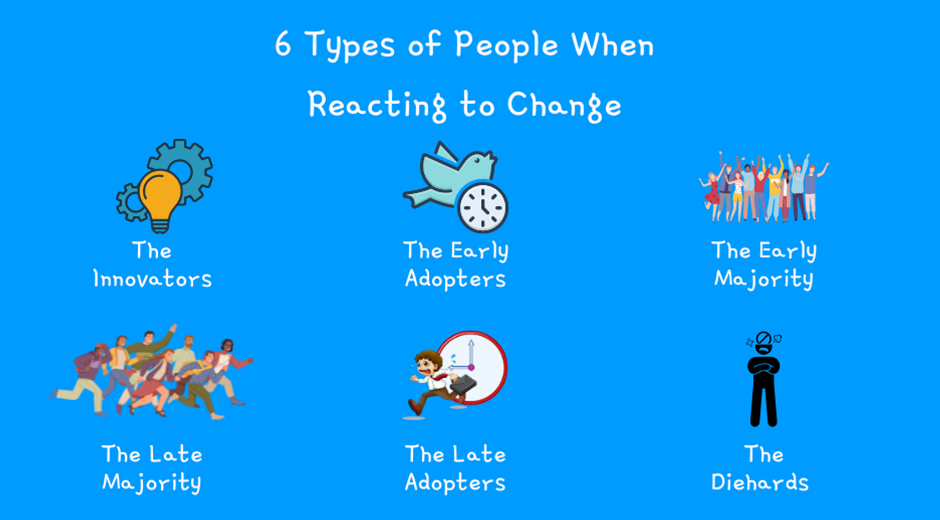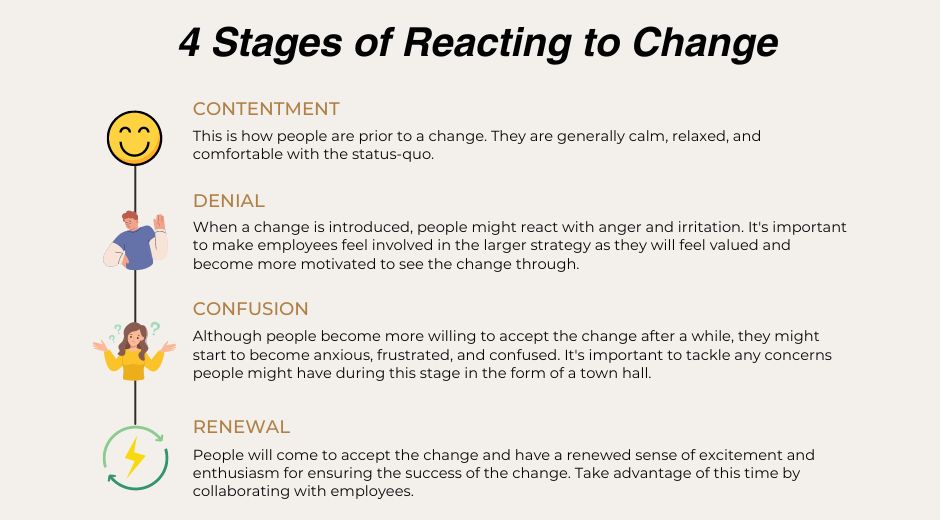One of the hardest barriers to overcome when making organizational changes is managing employee reactions to change. This is true of any major transformation that occurs within a company and certainly needs to be considered as part of any successful ERP change management strategy. Change triggers an emotional response and feelings such as sadness, anxiety, loss, anger, fear, and resentment which are all natural responses to change.
Even though change is an essential element of the world and must be accepted, everyone deals with change differently and people have diverse approaches to change. Some completely and quickly embrace and seek change, while others will do everything in their power to prevent change.
As an organization, it’s important to identify strategies for accepting and implementing change in order to grow your business and achieve your strategic goals.
This article provides information on how to successfully work with managers and staff to implement change, how to prepare for organizational change, strategies for getting employees onboard for change and for dealing with reactions to change, and how to make changes stick.
We’ll Cover:
- Why Change is Important in the World of Digitalization
- What is Change?
- The Three Phases of Change
- How People React to Change
- Framework for Reacting to Change
- Getting Change to Stick
Why Change Is Important: Digitalization
Change is vital in a business world that has become increasingly digitized. Through automation, the rise in cloud technology, the advancement of AI and other technological advances, organizations can’t avoid making changes and should encourage their employees to embrace it.
Now more than ever, adapting to technological changes within the business world is extremely important.
Digitizing specific business processes increases efficiency and productivity while giving management and business owners easier access to data. Taking on a data-driven approach makes your firm more competitive and identifies areas for opportunity ultimately leading to growth.
Examples of processes your company can digitize:
- Implementing barcode scanning
- POS
- Electronic document storage
- API integration (etc).
If you are unable to digitize in time to stay ahead of your competitors and continue to use legacy systems or sunset software, your business could find itself lagging behind.
What is Change?
To prepare your company for change, it’s important to understand what change is. Change goes hand-in-hand with transition and there is a distinct difference between the two. Change refers to the actual situation – in this case, implementing a new piece of software to be used and embedded into processes business-wide. Transition, on the other hand, is a three-phase process that people go through as they come to terms with a new situation and the change that has been brought. Therefore, helping employees during the transition process will help with implementing change.
3 Phases of Change
People tend to experience change in a 3-phase process:
Phase One: Endings
All change begins with an ending. It begins with letting go of something stable, known, and dependable. Even if employees intellectually accept a change, they may still emotionally resist it.
Phase Two: Neutral Zone/Transitions
It is during Phase Two that it makes the most sense to implement new processes. Once employees have had a chance to grieve an ending it is time to start looking forward. During this stage, employees may require additional support and you may see conflict between employees and departments. This is a critical stage for getting employees to learn, adapt and implement new processes and systems.
Phase Three: Beginnings
Phase Three is all about beginnings. Although a good leadership team at an organization is constantly thinking of beginnings and change, this information may not be relayed to employees. This can frequently cause conflict if leaders do not involve other stakeholders and employees early enough in the process. Organizations need people to make change happen and therefore involving the entire team and having a leadership team present a clear vision and purpose is critical.
How People React to Change
There are various ways in which people will react to change and transition to new beginnings. For a lot of people, this may be demonstrated through sickness, depression, frustration, lack of motivation, or shock – especially if too many things change at once. It’s in human nature to have a need for control, and therefore, if reality doesn’t match expectations due to organizational change, employees will lose a sense of control and resist change. Acknowledging and being aware that resistance is a natural reaction to change will help your organization better prepare for and react to any push-back from employees
People react differently to change, but we can generally categorize people according to the following:
The Innovators
Innovators are the first people to adapt to change. These people are more willing to take risks, are motivated by change, and will help to push for change.
The Early Adopters
Early Adopters are people on the team who will be the first to embrace the changes. These individuals are the second fastest category who adopt an innovation and they may even rush in before they understand the change and why it’s necessary.
The Early Majority
The Early Majority are susceptible to influence by The Innovators and Early Adopters. People in this category adopt an innovation after a varying degree of time.
The Late Majority
The Late Majority are more cautious and skeptical of change. They only feel comfortable embracing change when they know what they are doing and they believe the change has a fair chance of being successful. People in this category will adopt an innovation only after the average member of society does.
The Late Adopters or Laggards
Laggards are the last to embrace a change and may not do so willingly. These people typically have a strong aversion to change and tend to focus more on the traditional way of doing things. Although they are not easily convinced of the value of change, with the right amount of persuasion, they can be moved to accept the change – usually only once they see the benefit or are at threat of being left behind.
The Diehards or “Blockers”
Blockers are people who entirely resist change. They can become angry and bitter with the changes that are happening and as a result, may need to be terminated – especially if their resistance starts to influence other employees.
Who Should You Focus On?
Although it may seem important to get those resistant to change onboard, it is more important to focus your efforts on the Innovators and Early Adopters. These groups of people can then help to influence the remaining groups of employees and can act as change agents in your organization. Find out who these people are and involve them in the change process as early as possible.
Even though the Diehards or Blockers can sometimes be the most disruptive and vocal, your attention is best spent working with the Innovators and Early adopters. That being said, it is important not to give Diehards a platform for expressing their resistance as you do not want them to have any influence over people who fall in the middle (and are on the fence).
Remember, when 5% of the people in a group adopt a change, the change is embedded. When 20% adopt it, the change is unstoppable. Statistically, the Innovators, Early Adopters and Early Majority tend to make up 20% of people in an organization.
The Framework for Reacting to Change
Within a successful change management strategy, it's important to understand how people's reactions will develop over the course of time. Below, we can visualize a framework of different characteristics and feelings people may experience:
The idea with this model is that people will continuously cycle through each emotion, but there are ways in which your organization can better manage people throughout each stage.
Contentment
This is the status quo. People who feel content are more confident, calm and relaxed. They are more willing to compromise and feel a sense of belonging and optimism.
Denial
During this stage, people can become irritated, bored and tense. They may become defensive with arguments against the change such as “we’ve tried this before and it didn’t work”. In general, people are good at adapting to change, but more so when it’s their own idea.
Due to this, it’s important to be transparent and involve employees throughout the change process to make them feel like they’re involved in the larger strategy. When employees are angry about change, it’s important to listen to and acknowledge their feelings, without taking blame or agreeing with their frustrations. Listening is twice as important as talking.
Confusion
During this stage, people will experience anxiety, but they are becoming more willing to accept a change. There may be feelings of frustration, and abandonment which can cause people to feel paralyzed and feel helpless. When people are confused, they can stop being cooperative. During this stage, consider holding a town hall to clarify information and have a “go-to” support person for fielding questions and concerns. Don’t be afraid to tell people that you don’t fully know what will happen – as long as you provide some insight into how you plan to figure this out. If you are not sure if you’re communicating enough to staff, ask them. And if you do decide to hold a town hall, ask employees to share any rumors they have heard about the changes so that you can provide clarity.
Renewal
During the renewal stage, there will be a sense of rejuvenation and enthusiasm to carry out the change that has been presented. People will have lots of energy for creative work and will then go back to being content until the next change happens. Take advantage of this stage by working with employees to continue to adopt processes, seek out new opportunities, and look for ways to grow the business.
Getting Change to Stick
Resiliency is the ability to bounce back from change, focusing on the positive outcomes without getting caught up in negative reactions. Some people will naturally be more resilient to change than others, but for those that struggle with change, resiliency can be taught and modeled. In order to develop resiliency, people need to develop the following 5 characteristics.
(1) Positive Attitude:
Having a positive attitude will make all the difference in accepting change. To teach this skill to employees, try getting them to reframe any negative thoughts into positive ones. This will help them to see the change as an opportunity and will lead them to eventually believe in what they are repeating.
(2) Focus:
Staying focused on the change without getting caught up in things outside of your control will help employees adapt to the change more quickly. Help employees stay focused by creating an action plan with specific milestones, sticking to a schedule and identifying where employees are in the model to help block out distractions and negative gossip.
(3) Flexibility:
This may seem obvious, but change will be much easier if you embrace it. Instead of focusing on the negatives, identify ways in which you can better adapt to the change through additional training and support. Celebrate employees that are flexible to the change and bring it to the attention of the rest of the team.
(4) Organization:
If you can organize and schedule change in a logical fashion, it will make the changes seem less daunting and easier to handle. Help employees create and update plans by providing relevant information and training on time management and productivity where appropriate.
(5) Be Proactive Early:
Communication is key to change. The ability to anticipate change and to begin to adapt accordingly will provide much more positive results than change that comes as a surprise. Make sure to communicate with your team and provide a safe avenue where they can also communicate and ask questions. Set expectations on timelines and updates.
ERP Change Management
The key to a successful transformation within a company begins with change management. Considering that 70% of transformations within a company fail, it is going to be a challenge to ensure that your company beats the odds and gets it right. Companies that can be proactive and manage the situation with the strategies outlined in this blog will be more likely to have a successful transformation.
Changing your ERP system or implementing one for the first time can be one of the big changes that your company must be prepared for. Your ERP is your organization’s backbone as it helps to integrate all your business processes into one all-in-one solution. The transition to a new ERP system is one that is daunting but necessary for the growth of your company. To ensure that your ERP change management strategy is successful, you need to have a supportive provider and a plan for ensuring that everyone in your organization is on the same page about the change. Once you can manage employees' reactions to change successfully and find a provider that can help you make the transition seamlessly, your new ERP will help grow your company significantly.












